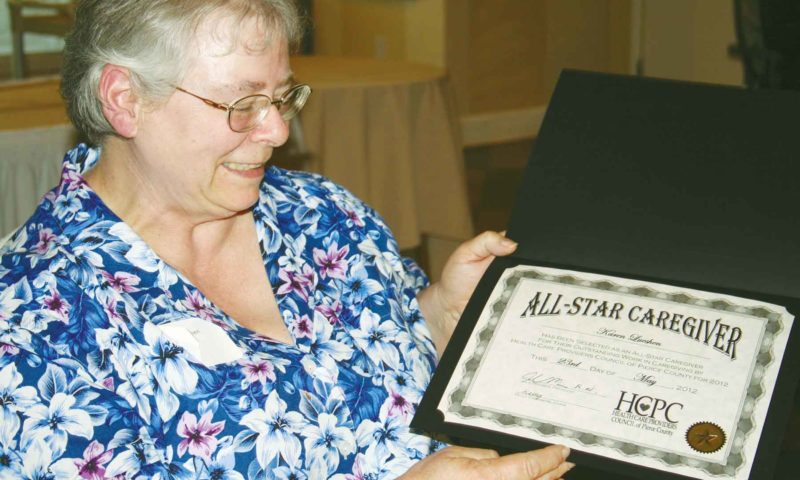Getting up to speed

In September, I received a phone call from a Goodyear representative who wanted to know if I were interested in attending a demonstration about tires. If you’ve been reading the “Senior Scene” for any length of time, you know the paper doesn’t have an automobile section. So I nearly told the rep that I wasn’t interested except that I’d received several phone calls recently and it got me to thinking.
After about the age of 16, we take the act of driving for granted. Gone are the days when only the man in the family drives. Most families financially support multiple vehicles and their various insurances and expensive-to-fill gas tanks. All that changes if a health crisis occurs. One of my callers had just been diagnosed with Alzheimer’s disease. She was still early in the life of the disease, but as soon as she received the diagnosis, she discovered she needed to take a driver’s test. The second caller had had a stroke. She needed to take a test to be able to drive again. Both callers began to see just how much narrower their lives might become based on a test many of us will usually have only a handful of times. Transportation options are extremely limited, especially for folks who may have not been limited since the days when their folks told them they had to be back by night fall. And with limited transportation comes limited opportunities to go out just for fun or to meet up with friends or family. Your big world can just that quickly become limited to how far you can walk or whether or not you’re on an active bus line. See how your driving stacks up here.
So I went. A whole passel of Goodyear folks showed up to take a BMW 321i for a test drive and experience the difference between the Goodyear Eagle F1 Asymmetric All-Season and Michelin’s similar high performance tire. And then there was me. In all honesty, there are little old ladies that probably complain that I drive like a little old lady. I don’t like paying for the privilege of getting to the next location a few minutes sooner so I drive speed limit and follow all traffic laws. This makes me a good driver (maybe) but not a gutsy driver.
The Goodyear employees were all men and they blew through the course as if it were a life-time personal dream of theirs to recklessly drive someone else’s vehicle. Driving at my much more sedate speed meant there wasn’t really much difference between one tire and the next.
At the break between driving a dry course and a wet course, a Goodyear rep talked about how Texas just changed their highway speed to 85 miles per hour and how other states are thinking about following suit and suddenly high performance tires made a whole lot more sense, especially if I was thinking about doing any traveling.
This leads me to a second reason to write about driving in the “Senior Scene.” Despite Perry Como’s song about our skies, on this side of the mountain you’re more likely to see rain than sun. Dry weather isn’t necessarily the best thing either, since the first real rain we get after a dry spell turns our streets into oil slicks. The most frequent noise on the hills around Tacoma after a rain is the scream of tires trying to get traction. Stopping half-way up a hill because a traffic light turned red can turn you into a believer in good tires. Regardless of what tire you have on your car, replacing tires when the tread becomes worn, keeping your tires properly inflated and driving at a slower pace will increase your traction. See here for more tips.
The Goodyear course was set up at the Tacoma Dome. It was nice and flat with sprinkler systems arranged to simulate an easy rainfall. Driving at or just above highway speeds and changing lanes on wet pavement to avoid the knucklehead who just pulled in front of you pretty closely resembles what driving the track was like. I’d like to say that all on my own, I ratcheted up my driving but it honestly took a professional driver sitting in the suicide seat and giving me pointers to get me flying through the wet course.
This is point number three that I wanted to make. It’s been decades since I took a driving test. Even at my usual speed, the professional beside me had some tips to improve my driving. Once I achieved a faster speed, he very patiently provided even more guidelines. Most of us believe that if our passengers can ride without clinging to the suicide strap or pumping their feet through the floor and we mostly avoid traffic tickets that we’re safe drivers. We drive but we don’t spend time analyzing our driving. It was educational to sit next to someone whose work life is dedicated to driving. I was excited when I walked off that track which made me wonder, “Wouldn’t it be great if everyone could experience that.” They ought to have classes or something that allowed you to drive around at breakneck speed and build your confidence level. Well, of course my trademarked idea was already being used. Check out the driving school sidebar.
So, did I see a difference in performance between Goodyear’s tires and Michelin’s. Yes. I don’t know if that’s because the track was stacked with a bias for Goodyear or not as I honestly still don’t know much about tires but I definitely believe you should buy the best tire you can afford. If you can afford it that might be the Goodyear Eagle F1 Asymmetric All-Season. But, I also believe that you’re always happiest with a product when the team responsible for helping you make the decision listens to you, works within your limitations and genuinely wants your experience to be the best it can be and maybe that’s the real reason I walked off that track with the world’s biggest smile.




